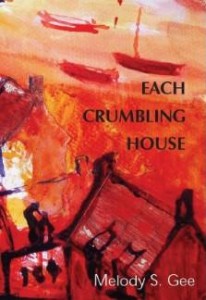
Each Crumbling House by Melody S. Gee | Perugia Press 2010 | $16
Melody S. Gee’s first book of poems has been advertised for its first-generation Asian American experience, a perhaps unfair label that evokes an older generation’s assimilation-preoccupied narratives. Gee’s poems subsume that historical genre and renew it through her family’s multiple generations. Though the poems do aggregate around immigration, they also address the return to motherland and a Pacific-straddling awareness that’s neither here nor there. Most of these poems are trenchant with cultural identity’s complexities, with both China and America composing the poet’s (or at least the poet’s family’s) world-center.
The primary, migratory narrative buttresses each of the book’s two sections, including the “Paper Son” strain, the W poems (“What They Saw,” “Where We Are Gathered,” etc.), and the dated/located poems. The opening poem, “Migration,” uses monarch butterflies to explore estranged inheritance. The monarch is common to an American childhood but foreign to a Chinese one; between two generations emerges a rift of (de-)naturalization, so that the speaker inherits, variously: sacrifice, beauty, foreignness, destination. These lines from the poem elucidate the space this book inhabits:
how much more time have you been given
to learn a language and forget a language, to break
your body over an ocean [. . .]
As in all poetry, language is at stake here. There’s English and there’s Chinese; but there’s also Mandarin and Cantonese, the former of which the speaker’s mother cannot speak when bartering for souvenirs in “Southern Xi’an Road,” the latter of which also deteriorates that same year of travel in Hong Kong in “What You Remember.” As we jump from poem to poem, through China, through California, from 2001 to 1958 to 1931 and so on, language limns but remains liminal. “In Translation” struggles with words’ imperfect communication, their “texture” and implications, the speaker “[a]lways / a word away from the word I need.”
Gee’s rhetoric tends toward dialectics. She has divided the book in two parts; the second begins with an epigraph from The Tempest, reaching backward and forward at the same time: “what’s past is prologue; what to come / In yours and my discharge.” Poems with rain inevitably invoke fire; sweetness often begs of bitterness. The poem title “Two in Which the Door” means a door can only swing in two directions. In “Gas Fire,” “We are letting go / or being let go.” In “The Field Is Not Us,” we end on this rhetorical repetition:
Either light escapes,
or it returns. Either we
are real, or we remember.
This is not to say, however, that Gee actually believes the choice is either/or. For her, prologue does not mean a satisfied past: “how worn the path of prologue. And how / little changes. [. . .] How we thirst while we drink.” In her title poem she writes with loaded syntax of “each crumbling house / I have already rebuilt.” The gerund “crumbling” refers to a continuous past, the “already” refers to expectations from the future, and “rebuilt” makes the past malleable, narrative, mythical. The cultural experience of language does not simplify into dichotomy either, as we saw above with Chinese’s multiple dialects and the deterioration of speech. Nor does tension exist only between China and America; in “Internment Farm,” the migration cycles of a single camp include the Japanese, complicating perspectives of suffering with the Rape of Nanking. By establishing dichotomies to confound them, we learn, as in “The Flesh and the Valley,” that “the broken thing is more / itself now, and it need / not heal to be whole.”
The poems communicate rather than explore, which is to say the poet seems to already know what she wants to express when each poem begins. The collection as a whole, however, interacts in a process of discovery, donning a variety of modern styles: the forms discourse, seek a language apposite to the occasion. Gee comes close to finalizing a signature style in poems with rhythmically measured stanzas, unpredictably oscillating tercets and quatrains, or between indentation patterns. Poems like “Sightseeing” make appendages of tercets, indenting the first and sometimes the last line of each stanza. Her off-kilter sense of symmetry is remarkable. Some poems inherit Anne Carson’s style of alternating long and short lines, one launching its rhythm into the other:
When Ah-Hoo shells pistachios with me, she peels back 1959
and the Great Leap Forward
as Mao snaked through the country toward your village,
how close they came
to turning Li-Hong Lei into a commune.
Some poems do not cohere with the whole. The content of “Fear” is so generic as to be disjointed. “It Was so Sweet and Cold,” a too-cerebral Imagiste/Williams imitation, lacks the substance of other poems. Some of Gee’s images freshen the English idiom (“buttoning your eyes”) while others slacken the senses (“the yellow hum of the bus,” for instance, is a lazy use of synesthesia). Many of her endings rely on the progressive tense to zoom out and inflect sentiment, which in some poems works well, but in others stagnates into melodrama, as do many other tricks that pall when, cumulatively, they serve no argument but adornment.
Altogether, Each Crumbling House is an intelligent first book. The “Paper Son” series commands special attention. Other rewarding reads include: “Against Elegy,” “What They Saw,” and the California prose poems “Heel to Head” and “Vineyards and Orchards.” This book refreshes the first-generation genre, if we must call it that, providing an oblique family history through reconstructed sense and memory. Gee’s voice is new in the sense that it’s in a ferment; she inherits multiple traditions, which in this collection shows promise for her future work.
One thought on “Review: Melody S. Gee’s EACH CRUMBLING HOUSE”